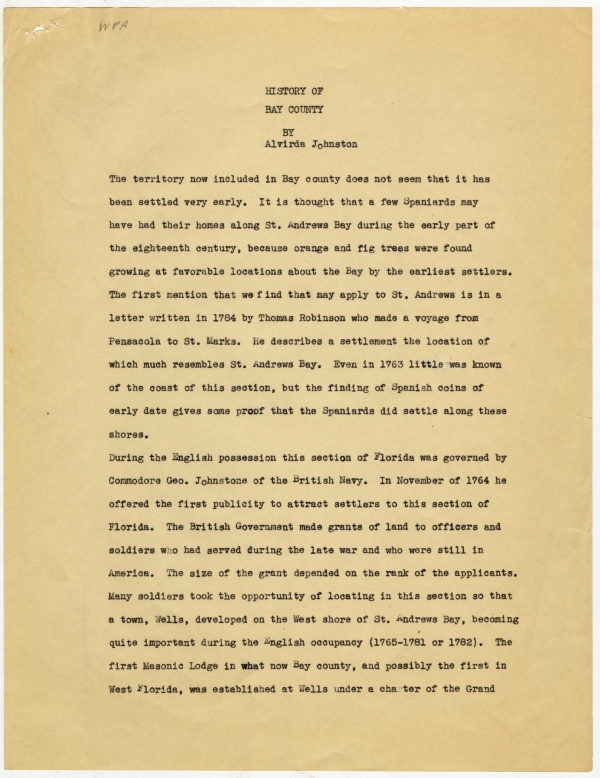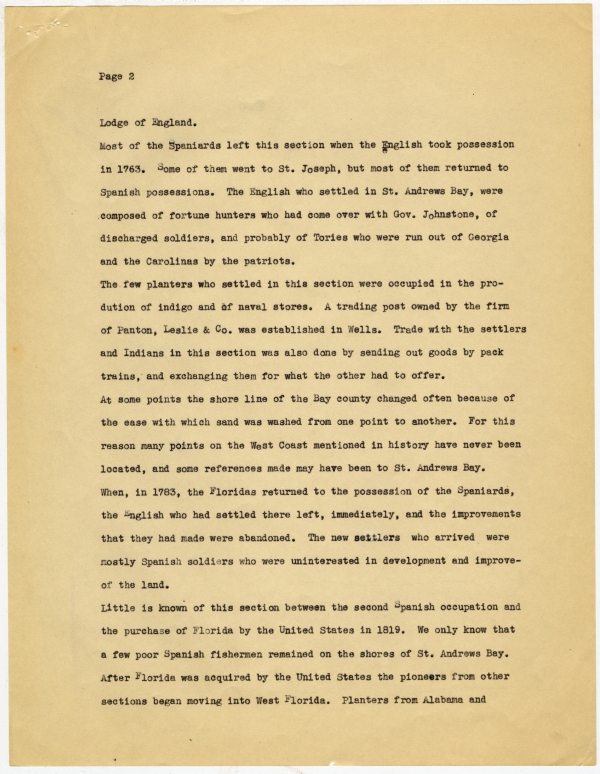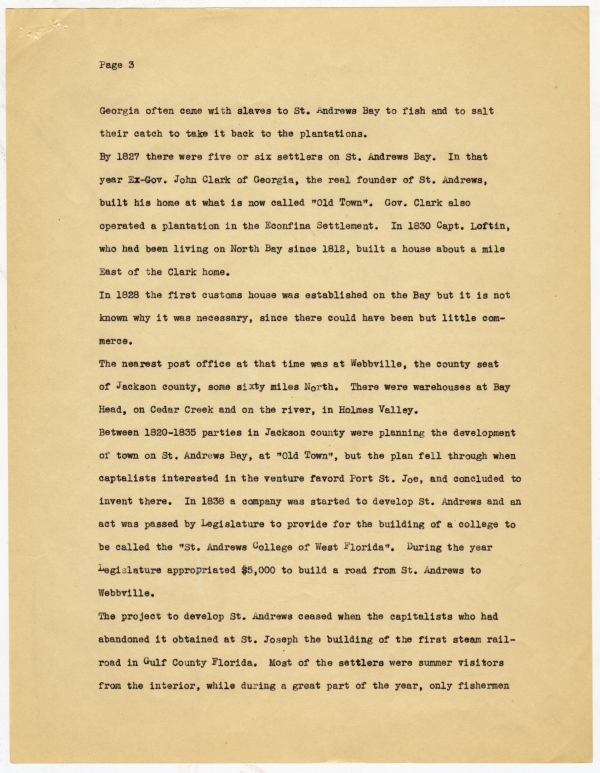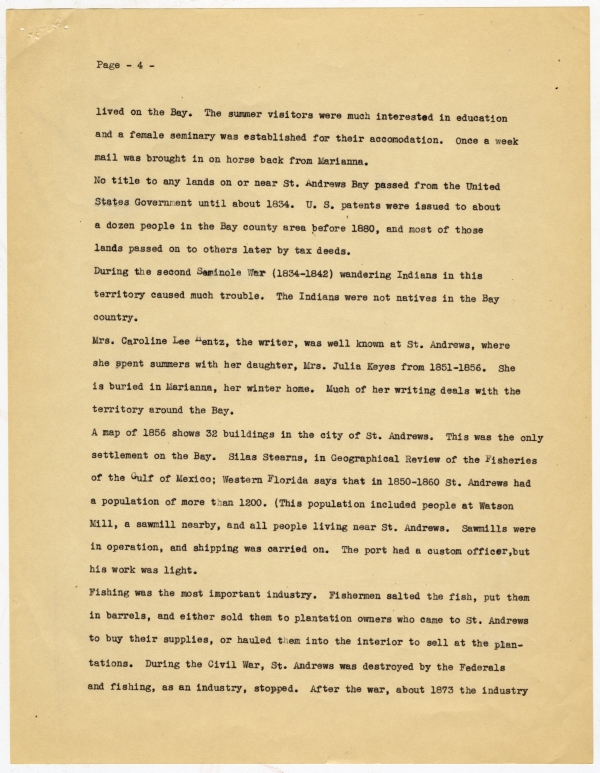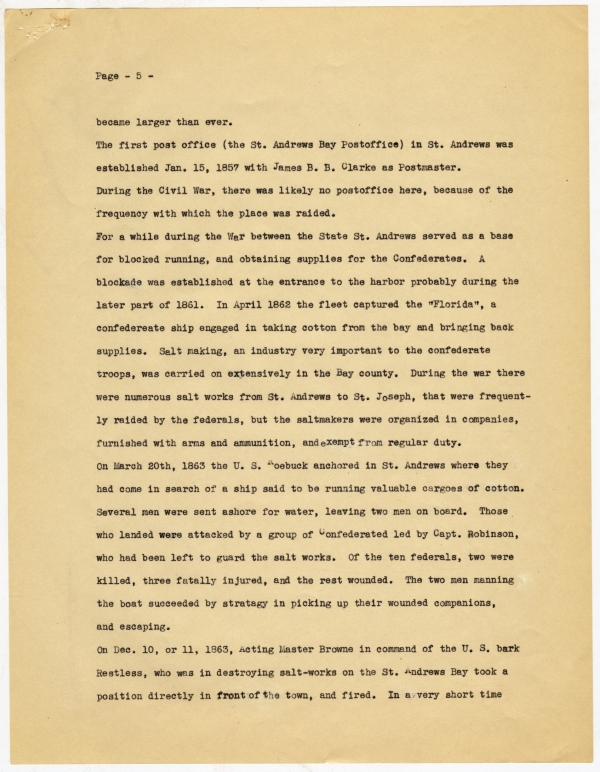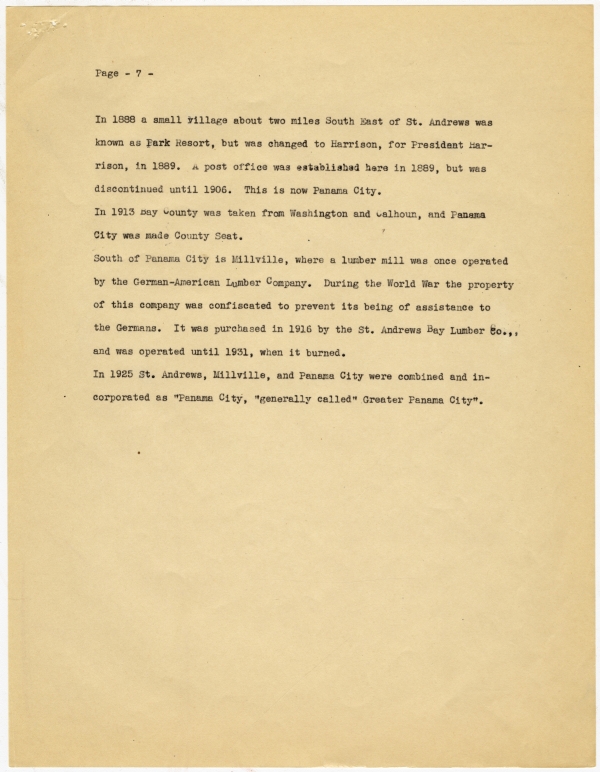Transcript
WPA
HISTORY OF
BAY COUNTY
BY
Alvirda Johnston
The territory now included in Bay county does not seem that it has been settled very early. It is thought that a few Spaniards may have had their homes along St. Andrews Bay during the early part of the eighteenth century, because orange and fig trees were found growing at favorable locations about the Bay by the earliest settlers. The first mention that we find that may apply to St. Andrews is in a letter written in 1794 by Thomas Robinson who made a voyage from Pensacola to St. Marks. He describes a settlement the location of which much resembles St. Andrews Bay. Even in 1763 little was known of the coast of this section, but the finding of Spanish coins of early date gives some proof that the Spaniards did settle along these shores.
During the English possession this section of Florida was governed by Commodore Geo. Johnstone of the British Navy. In November of 1764 he offered the first publicity to attract settlers to this section of Florida. The British Government made grants of land to officers and soldiers who had served during the late war and who were still in America. The size of the grant depended on the rank of the applicants. Many soldiers took the opportunity of locating in this section so that a town, Wells, developed on the West shore of St. Andrews Bay, becoming quite important during the English occupancy (1765-1781 or 1782). The first Masonic Lodge in what [is] now Bay county, and possibly the first in West Florida, was established at Wells under a charter of the Grand
Page 2
Lodge of England.
Most of the Spaniards left this section when the English took possession in 1763. Some of them went to St. Joseph, but most of them returned to Spanish possessions. The English who settled in St. Andrews Bay, were composed of fortune hunters who had come over with Gov. Johnstone, of discharged soldiers, and probably of Tories who were run out of Georgia and the Carolinas by the patriots.
The few planters who settled in this section were occupied in the [production] of indigo and of naval stores. A trading post owned by the firm of Panton, Leslie & Co. was established in Wells. Trade with the settlers and Indians in this section was also done by sending out goods by pack trains, and exchanging them for what the other had to offer.
At some points the shore line of the [sic] Bay county changed often because of the ease with which sand was washed from one point to another. For this reason many points on the West Coast mentioned in history have never been located, and some references made may have been to St. Andrews Bay. When, in 1783, the Floridas returned to the possession of the Spaniards, the English who had settled there left, immediately, and the improvements that they had made were abandoned. The new settlers who arrived were mostly Spanish soldiers who were uninterested in development and [improvement] of the land.
Little is known of this section between the second Spanish occupation and the purchase of Florida by the United States in 1819. We only know that a few poor Spanish fisherman remained on the shores of St. Andrews Bay. After Florida was acquired by the United States the pioneers from other sections began moving into West Florida. Planters from Alabama and
Page 3
Georgia often came with slaves to St. Andrews Bay to fish and to salt their catch to take it back to the plantations.
By 1827 there were five or six settlers on St. Andrews Bay. In that year Ex-Gov. John Clark of Georgia, the real founder of St. Andrews, built his home at what is now called “Old Town”. Gov. Clark also operated a plantation in the Econfina Settlement. In 1830 Capt. Loftin, who had been living on North Bay since 1812, built a house about a mile East of the Clark home.
In 1828 the first customs house was established on the Bay but it is not known why it was necessary, since there could have been but little commerce.
The nearest post office at that time was at Webbville, the county seat of Jackson county, some sixty miles North. There were warehouses at Bay Head, on Cedar Creek and on the river, in Holmes Valley.
Between 1820-1835 parties in Jackson county were planning the development of [the] town on St. Andrews Bay, at “Old Town”, but the plan fell through when capitalists interested in the venture [favored] Port. St. Joe, and concluded to invent there. In 1838 a company was started to develop St. Andrews and an act was passed by Legislature to provide for the building of a college to be called the “St. Andrews College of West Florida”. During the year Legislature appropriated $5,000 to build a road from St. Andrews to Webbville.
The project to develop St. Andrews ceased when the capitalists who had abandoned it obtained at St. Joseph the building of the first steam railroad in Gulf County Florida. Most of the settlers were summer visitors from the interior, while during a great part of the year, only fishermen
Page -4-
lived on the Bay. The summer visitors were much interested in education and a female seminary was established for their accomodation. Once a week mail was brought in on house back from Marianna.
No title to any lands on or near St. Andrews Bay passed from the United States Government until about 1834. U. S. patents were issued to about a dozen people in the Bay county area before 1880, and most of those lands passed on to others later by tax deeds.
During the second Seminole War (1834-1842) wandering Indians in this territory caused much trouble. The Indians were not natives in the [sic] Bay [county].
Mrs. Caroline Lee Hentz, the writer, was well known at St. Andrews, where she spent summers with her daughter, Mrs. Julia Keyes from 1851-1856. She is buried in Marianna, her winter home. Much of her writing deals with the territory around the Bay.
A map of 1856 shows 32 buildings in the city of St. Andrews. This was the only settlement on the Bay. Silas Stearns, in Geographical Review of the Fisheries of the Gulf of Mexico; Western Florida says that in 1850-1860 St. Andrews had a population of more than 1200. (This population included people at Watson Mill, a sawmill nearby, and all people living near St. Andrews. Sawmills were in operation, and shipping was carried on. The port had a custom officer, but his work was light.
Fishing was the most important industry. Fishermen salted the fish, put them in barrels, and either sold them to plantation owners who came to St. Andrews to buy their supplies, or hauled them into the interior to sell at the plantations. During the Civil War, St. Andrews was destroyed by the Federals and fishing, as an industry, stopped. After the war, about 1873 the industry
Page -5-
became larger than ever.
The first post office (the St. Andrews Bay Postoffice) in St. Andrews was established Jan. 15, 1857 with James B. B. Clarke as Postmaster.
During the Civil War, there was likely no postoffice here, because of the frequency with which the place was raided.
For a while during the War between the State St. Andrews served as a base for blocked running, and obtaining supplies for the Confederates. A blockade was established at the entrance to the harbor probably during the later part of 1861. In April 1862 the fleet captured the “Florida”, a confederate ship engaged in taking cotton from the bay and bringing back supplies. Salt making, an industry very important to the confederate troops, was carried on extensively in the Bay county. During the war there were numerous salt works from St. Andrews to St. Joseph, that were frequently raided by the federals, but the saltmakers were organized in companies, furnished with arms and ammunition, and exempt from regular duty.
On March 20th, 1863 the U.S. [R/K]oebuck anchored in St. Andrews where they had come in search of a ship said to be running valuable cargoes of cotton. Several men were sent ashore for water, leaving two men on board. Those who landed were attacked by a group of Confederated led by Capt. Robinson, who had been left to guard the salt works. Of the ten federals, two were killed, three fatally injured, and the rest wounded. The two men manning the boat succeeded by strategy in picking up their wounded companions, and escaping.
On Dec. 10, or 11, 1863, Acting Master Browne in command of the U.S. bark Restless, who was in destroying salt-works on the St. Andrews Bay took a position directly in front of the town, and fired. In a very short time
Page -6-
many of the houses were burning. Browne reported the destruction of thirty two houses, but it is believed that he [exaggerated] the real number.
This bombardment and burning came as retaliation for the preceeding incident. By the end of the war little was left of the settlement. Development was slow, but in 1867 a group of Marianna men met to discuss the building of a railroad North from St. Andrews Bay into Georgia. In 1886 the St. Andrews Bay Railroad Land and Mining Company was formed with J. H. Brown as one of its promoters. He had been employed as Postal Inspector in [Cincinnati], Ohio where he obtained the knowledge of Postal laws that kept the company clear of the law.
It has been said that some 350,000 lots were sold in this section to people in the United States. Many people wrote to the Florida governor asking for his advice before purchasing land, and were told that they should see the land first. Others fascinated by the advertisements, purchased lots and came to Florida, only to find that their property was valueless and that the proposed railway had fallen through. Some of those who came stayed and started settlements of their own. A newspaper, the “Messenger” was started, followed by the “Buoy”. The population of St. Andrews is said to have reached nearly 2,500 during this time.
Among the settlements established by Northerners enticed into these parts by the St. Andrews Bay Railroad, Land and Mining Company was Parker (settled by W. H. Parker), and Cromanton (named after W. M. Croman) both of which have their own postoffices. Lynn Haven, a northern settlement, was founded by Senator W. H. Lynn, of New York. It is incorporated and has its own post office.
Page -7-
In 1888 a small village about two miles South East of St. Andrews was known as Park Resort, but was changed to Harrison, for President Harrison, in 1889. A post office was established here in 1889, but was discontinued until 1906. This is now Panama City.
In 1913 Bay County was taken from Washington and Calhoun, and Panama City was made County Seat.
South of Panama City is Millville, where a lumber mill was once operated by the German-American Lumber Company. During the World War the property of this company was confiscated to prevent its being of assistance to the Germans. It was purchased in 1916 by the St. Andrews Bay Lumber Co.,, [sic] and was operated until 1931, when it burned.
In 1925 St. Andrews, Millville, and Panama City were combined and incorporated as “Panama City, “generally called” Greater Panama City”.

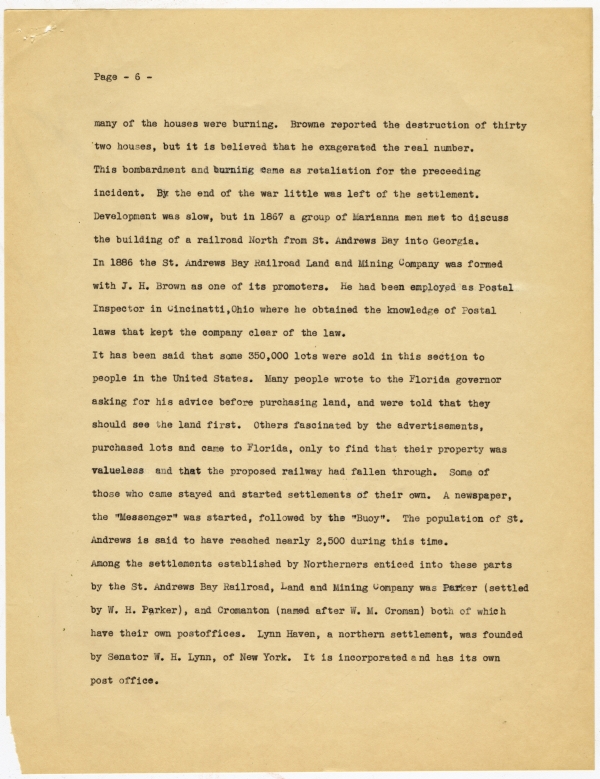


 Listen: The Blues Program
Listen: The Blues Program